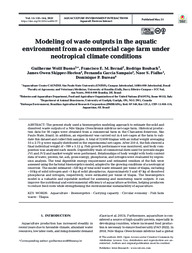Modeling of waste outputs in the aquatic environment from a commercial cage farm under neotropical climate conditions.
Modeling of waste outputs in the aquatic environment from a commercial cage farm under neotropical climate conditions.
Author(s): BUENO, G.; BERNAL, F.; ROUBACH, R.; SKIPPER-HORTON, J. S.; SAMPAIO, F.; FIALHO, N.; BUREAU, D.
Summary: Abstract: The present study used a bioenergetics modeling approach to estimate the solid and dissolved waste outputs of a Nile tilapia
Publication year: 2023
Types of publication: Journal article
Unit: Embrapa Environment
Observation
Some of Embrapa's publications are published as ePub files. To read them, use or download one of the following free software options to your computer or mobile device. Android: Google Play Books; IOS: iBooks; Windows and Linux: Calibre.
Access other publications
Access the Agricultural Research Database (BDPA) to consult Embrapa's full library collection and records.
Visit Embrapa Bookstore to purchase books and other publications sold by Embrapa.

